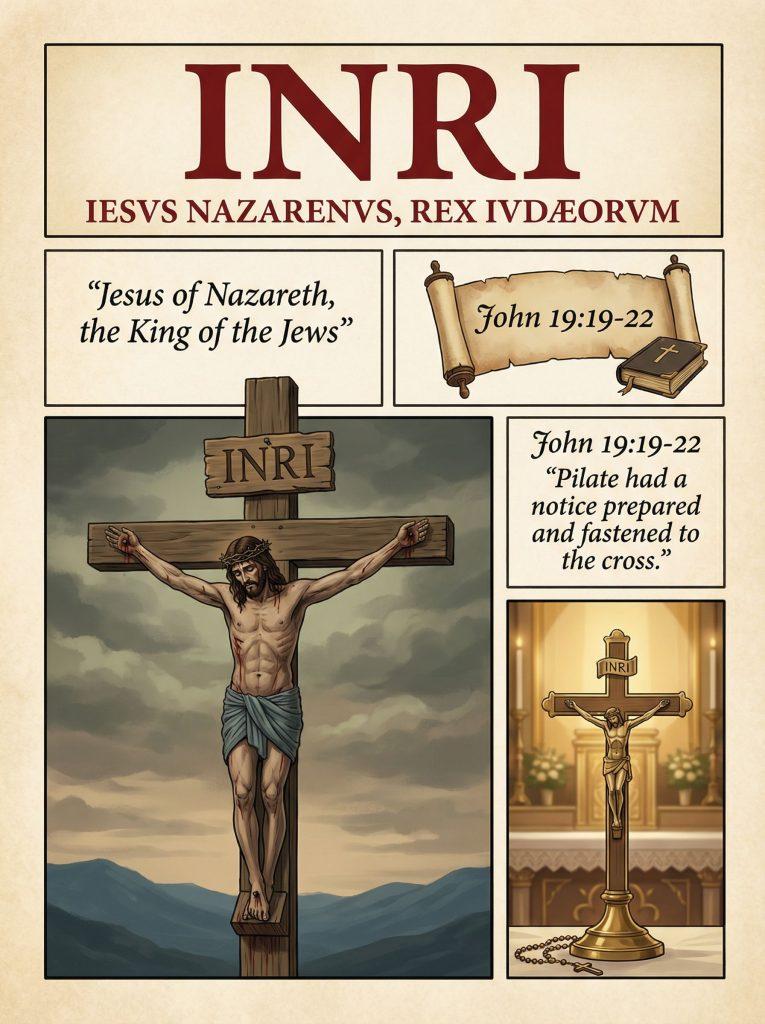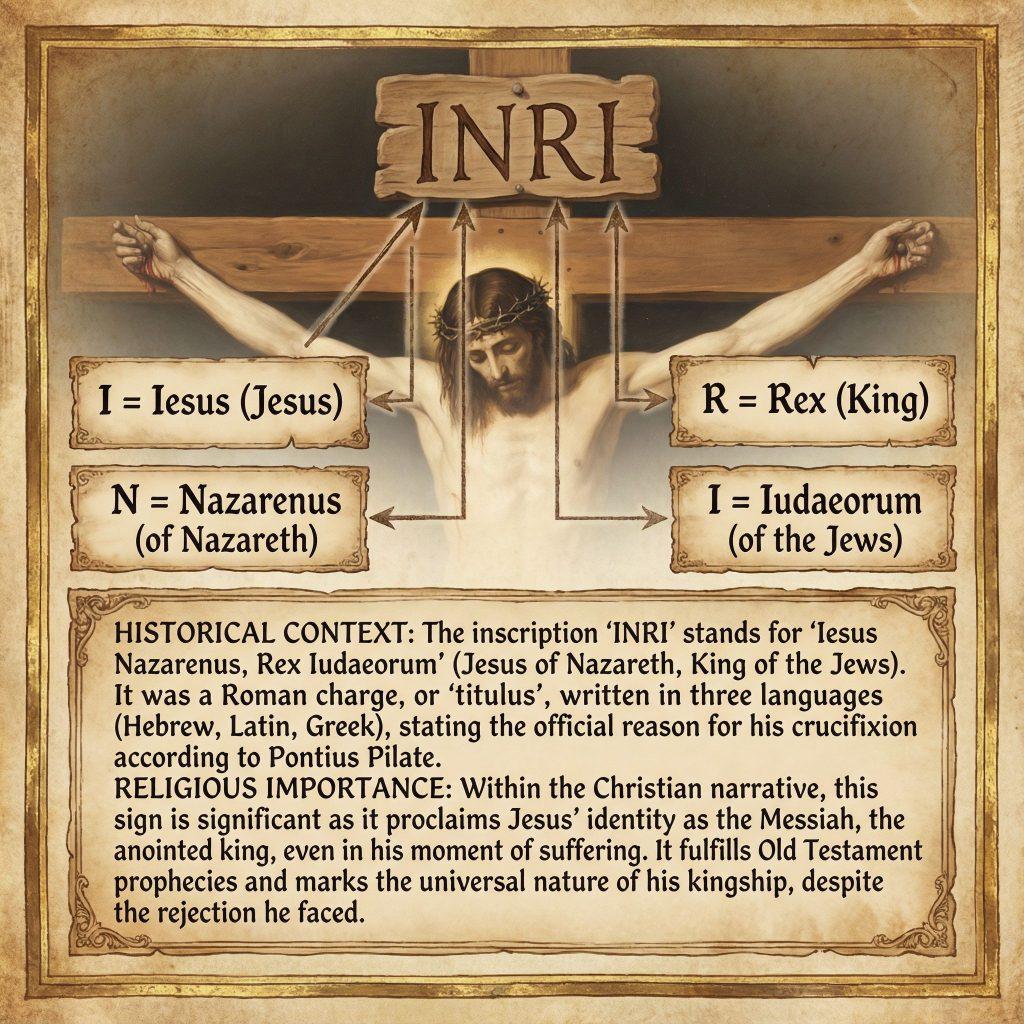Brief Overview
- INRI is an abbreviation commonly seen on crucifixes in Catholic churches and homes.
- It represents a Latin phrase tied to the crucifixion of Jesus Christ.
- The phrase comes from the sign placed above Jesus’ head on the cross, as described in the Gospels.
- Understanding INRI offers insight into the historical and theological significance of the crucifixion.
- This article will explain its meaning, origin, and importance in Catholic tradition.
- The explanation will draw from scripture, history, and Catholic teaching for clarity.
Detailed Response
What INRI Stands For
The letters INRI stand for Iesus Nazarenus Rex Iudaeorum, which is Latin for “Jesus of Nazareth, King of the Jews.” This phrase is rooted in the accounts of Jesus’ crucifixion found in all four Gospels: Matthew 27:37, Mark 15:26, Luke 23:38, and John 19:19-20. According to these texts, Pontius Pilate, the Roman governor, ordered a sign to be placed above Jesus on the cross. The sign declared the charge against Him, identifying who He was and why He was being executed. In Catholic crucifixes, INRI is often inscribed at the top to recall this moment. The use of Latin reflects its historical role as the official language of the Roman Empire and later the Church. This abbreviation has become a familiar symbol for Catholics worldwide. It serves as a reminder of Jesus’ identity and His sacrifice. The Catechism of the Catholic Church (CCC 213-214) discusses Christ’s titles, including His kingship, which ties to this inscription. In short, INRI captures a key detail of the crucifixion narrative.

The Historical Context of the Sign
In Roman times, it was standard practice to place a sign, called a titulus, above a crucified person. This sign stated the crime for which the individual was being punished. For Jesus, the charge was claiming to be a king, which challenged Roman authority. The Gospel of John 19:19-22 notes that Pilate wrote the inscription himself and refused to change it despite objections from Jewish leaders. The text was written in three languages—Hebrew, Latin, and Greek—to ensure it was understood by all who passed by. This detail highlights the public nature of Jesus’ execution. Historians confirm that such signs were common in Roman crucifixions, adding credibility to the Gospel accounts. The inclusion of multiple languages also shows the diverse population under Roman rule. For Catholics, this historical practice underscores the reality of Christ’s suffering and death. It connects the crucifixion to a specific time and place in history.

Why Pilate Chose This Wording
Pontius Pilate’s decision to label Jesus as “King of the Jews” has been a subject of debate among scholars. The Gospels suggest Pilate may have intended it as mockery or political provocation. In John 19:21, the Jewish leaders asked Pilate to alter the wording to say Jesus only claimed to be king, not that He was one. Pilate’s refusal could indicate his frustration with the situation or an assertion of Roman power. Some Catholic theologians see an unintended truth in Pilate’s words, reflecting Christ’s real kingship. This aligns with the Church’s teaching on Christ as the eternal King (CCC 664). Regardless of Pilate’s motive, the inscription became part of the crucifixion story. It has since taken on deep meaning for Catholics. The irony is not lost: a title meant to shame Jesus now proclaims His triumph. This tension between human intent and divine purpose is central to Catholic reflection on the cross.
The Theological Meaning of “King of the Jews”
In Catholic theology, Jesus’ title as “King of the Jews” carries profound significance. It points to His role as the Messiah promised in the Old Testament. Scriptures like Zechariah 9:9 describe the Messiah as a king who brings peace, which Jesus fulfilled in a spiritual sense. Unlike earthly kings, His kingdom is not of this world, as He told Pilate in John 18:36. The Catechism (CCC 440) explains that Jesus accepted this title while redefining it through His sacrifice. On the cross, His kingship was revealed not in power but in humility and love. This is why INRI is more than a historical note for Catholics—it’s a theological statement. It invites believers to see Christ’s death as the establishment of His reign. The crucifix, with INRI above it, becomes a symbol of victory over sin and death. Thus, the title reflects both His identity and His mission.
INRI in Catholic Art and Symbols
The use of INRI on crucifixes is a long-standing tradition in Catholic art. Early Christian depictions of the cross often included the titulus to emphasize the historical event. Over time, as Latin became the Church’s liturgical language, INRI emerged as a shorthand. This abbreviation appears in paintings, sculptures, and stained glass across centuries. It serves a practical purpose, fitting neatly above the figure of Jesus. More importantly, it keeps the viewer focused on the Gospel narrative. Artists have used it to convey both the suffering and the glory of the crucifixion. In churches, the crucifix with INRI is a central object of devotion. The Catechism (CCC 616-617) ties the cross to Christ’s redemptive act, which INRI helps recall. For Catholics, it’s a visual cue to meditate on Jesus’ sacrifice.
The Role of Latin in the Church
Latin’s prominence in the INRI abbreviation reflects its historical role in Catholicism. As the language of the Roman Empire, it was the tongue of law and governance during Jesus’ time. Later, it became the Church’s official language for liturgy and doctrine. This made Iesus Nazarenus Rex Iudaeorum a natural choice for the inscription’s lasting form. Even after vernacular languages entered Catholic worship, Latin retained its symbolic weight. The Second Vatican Council (1962-1965) allowed Masses in local languages, yet Latin traditions like INRI endured. For Catholics, this continuity links them to the early Church. It also connects the crucifixion to the broader history of salvation. The Catechism (CCC 1203) acknowledges the value of Latin in preserving Church heritage. Thus, INRI’s Latin form carries both historical and spiritual meaning.
How INRI Differs Across Gospel Accounts
The four Gospels present slight variations in how they report the inscription. Matthew 27:37 says, “This is Jesus, the King of the Jews.” Mark 15:26 simplifies it to “The King of the Jews.” Luke 23:38 notes it was written in three languages, while John 19:19-20 gives the fullest version: “Jesus of Nazareth, King of the Jews.” These differences reflect the authors’ perspectives and audiences. Despite the variations, the core message remains consistent. Catholic scholars see no contradiction, only complementary details. The Church accepts Iesus Nazarenus Rex Iudaeorum as the authoritative Latin rendering. The Catechism (CCC 133) affirms the unity of the Gospels’ testimony. For believers, INRI unifies these accounts into a single, powerful truth.
INRI and the Passion Narrative
INRI is a key element in the Catholic understanding of the Passion. The Passion narrative, spanning John 18-19, details Jesus’ trial, suffering, and death. The sign above the cross marks the climax of this story. It shows how Jesus was mocked yet fulfilled His purpose. The Catechism (CCC 602-603) teaches that Christ’s death was an act of obedience to God’s will. INRI encapsulates this moment of humiliation turned into triumph. During Holy Week, Catholics reflect on the Passion through prayers like the Stations of the Cross. The crucifix, with INRI, is a focal point in these devotions. It invites contemplation of Jesus’ love and sacrifice. In this way, INRI ties the historical event to its spiritual impact.
The Universal Kingship of Christ
While INRI calls Jesus “King of the Jews,” Catholic teaching extends His reign to all people. The Feast of Christ the King, established in 1925, celebrates this universal kingship. The Catechism (CCC 786) explains that Christ’s authority transcends earthly boundaries. On the cross, He became king not just of one nation but of humanity. The inscription’s original intent was limited, but its meaning grew through faith. This reflects the Church’s mission to proclaim Christ to all nations. The crucifix with INRI symbolizes this truth in Catholic homes and churches. It reminds believers of their call to live under His reign. Theologically, it bridges the Old Covenant with the New. Thus, INRI speaks to both history and eternity.
INRI in Personal Devotion
For many Catholics, INRI enhances personal prayer and reflection. Seeing it on a crucifix prompts thoughts of Jesus’ suffering and love. It can be a focal point during the Rosary, especially the Sorrowful Mysteries. The Catechism (CCC 2705) encourages meditation on Christ’s life as a path to holiness. INRI aids this by anchoring the mind to the crucifixion. Some wear small crucifixes with INRI as a reminder of their faith. Others place them in homes as a sign of devotion. This practice connects individual believers to the larger Church. It also reinforces the reality of Christ’s sacrifice in daily life. In this way, INRI becomes a tool for spiritual growth.
Misconceptions About INRI
Some misunderstand INRI as a mysterious code or acronym unrelated to the Gospels. Others assume it’s a later Church invention, not a historical detail. The Gospel accounts and Roman practices refute these ideas. Another misconception is that it glorifies violence rather than redemption. Catholic teaching counters this by framing the cross as a sign of victory (CCC 618). INRI itself is neutral—it simply states what was written. Its meaning depends on how faith interprets it. Education about its origins can correct these errors. The Church encourages clear understanding over speculation. For Catholics, INRI is a fact with deep spiritual value.
INRI in Other Christian Traditions
While INRI is most associated with Catholicism, other Christian groups recognize it too. Eastern Orthodox crucifixes sometimes use Greek or Slavic versions of the phrase. Protestant traditions may omit it, focusing less on the crucifix itself. Yet the historical basis of the inscription is widely accepted. Differences arise in how it’s emphasized or displayed. For Catholics, INRI’s prominence reflects their devotion to the cross. The Catechism (CCC 2114) ties such symbols to worship of Christ alone. This distinguishes Catholic use from mere decoration. Across traditions, INRI remains a link to the crucifixion story. Its presence shows a shared Christian heritage.
The Crucifix as a Teaching Tool
In Catholic settings, the crucifix with INRI serves an educational purpose. It teaches the faithful about Jesus’ life and death. Priests and catechists often point to it when explaining the Passion. The Catechism (CCC 1674) supports using visible signs to deepen faith. INRI adds a layer of meaning, tying the object to scripture. Children in religious education learn its significance early on. Adults encounter it in homilies and devotions. This makes the crucifix more than art—it’s a lesson in salvation. The inscription ensures the historical event isn’t forgotten. Over time, it shapes how Catholics understand their beliefs.
INRI and the Resurrection
Though INRI is tied to the crucifixion, it also points to the resurrection. The kingship it declares was fully revealed when Jesus rose from the dead. The Catechism (CCC 652) links Christ’s death and resurrection as one redemptive act. On the cross, He accepted suffering; in rising, He claimed victory. INRI thus carries a dual message of sacrifice and triumph. Catholics see it as a sign of hope, not despair. The crucifix isn’t an endpoint but a step toward Easter. This perspective shapes how the Church uses INRI in worship. It connects Good Friday to the joy of the resurrection. In this light, INRI becomes a symbol of complete salvation.
Cultural Impact of INRI
Beyond the Church, INRI has influenced art, literature, and music. Medieval painters like Giotto included it in crucifixion scenes. Composers have referenced it in works about the Passion. Its image appears in films and books about Jesus’ life. This shows its reach beyond religious settings. For Catholics, such uses can deepen appreciation of their faith. They also spread awareness of the crucifixion’s details. The Catechism (CCC 1674) notes that culture can reflect Christian truth. INRI’s presence in society keeps the Gospel story alive. It remains a recognizable marker of Catholic identity.
Why INRI Matters Today
In modern times, INRI retains its relevance for Catholics. It connects believers to the historical roots of their faith. It also challenges them to see Christ’s kingship in their lives. The Catechism (CCC 908) calls Catholics to share in His mission through humility. INRI embodies this call, showing a king who served. In a world focused on power, it offers a counterpoint. It reminds the faithful of the cost of redemption. For some, it’s a quiet source of strength. For others, it’s a public witness to belief. Either way, INRI keeps the crucifixion central to Catholic life.
Conclusion: INRI’s Lasting Significance
The letters INRI sum up a pivotal moment in salvation history. They recall a sign meant to condemn but used by God to reveal truth. For Catholics, it’s a bridge between scripture, tradition, and devotion. It ties the cross to Christ’s identity as king and savior. Its simplicity belies its depth of meaning. Across centuries, it has guided prayer, art, and teaching. The Catechism (CCC 2011) frames Christ’s work as the heart of faith—INRI points directly to that work. It invites believers to reflect on the crucifixion’s purpose. In churches and homes, it stands as a quiet testimony. Ultimately, INRI is a small but powerful part of Catholic life.
Signup for our Exclusive Newsletter
- Add CatholicShare as a Preferred Source on Google
- Join us on Patreon for premium content
- Checkout these Catholic audiobooks
- Get FREE Rosary Book
- Follow us on Flipboard
-

Discover hidden wisdom in Catholic books; invaluable guides enriching faith and satisfying curiosity. Explore now! #CommissionsEarned
- The Early Church Was the Catholic Church
- The Case for Catholicism - Answers to Classic and Contemporary Protestant Objections
- Meeting the Protestant Challenge: How to Answer 50 Biblical Objections to Catholic Beliefs
As an Amazon Associate, I earn from qualifying purchases. Thank you.

